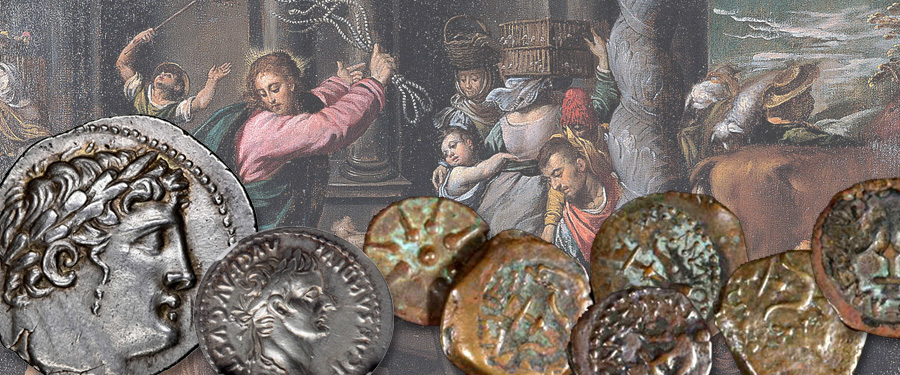
"Behold, you will conceive and give birth to a son, and you are to give Him the name Jesus." The words recorded in the Gospel of Luke 1:31 that herald the birth of Jesus form part of the famous nativity story often repeated at this time of year. The life of Jesus, a humble carpenter’s son from Judea, has indelibly and inextricably changed the course of human history. It is easy to forget that he lived as a normal inhabitant of Judea, and this normalcy extended to his use of money, and the lessons he learned from interacting with it.
The province of Judea had fallen under Roman rule in the first century B.C. near the end of the Roman Republic. Under the reign of Herod the Great, from 44-6 B.C., Roman rule crystalized in Judea, from a somewhat tenuous grasp, to holding it firmly within the Roman world. This late absorption into the Roman Empire, coupled with the chafing of Jewish monotheism with Roman paganism, always made Roman Judea a less than peaceful environment. Under this Roman domination, Jesus was born. According to the Gospel of Matthew, it was during the reign of Herod, though it is unclear if it was the rule of Herod the Great or his son, Herod Antipas. Most scholars date the birth of Jesus to circa 7-2 B.C. Given the tumultuous political situation of first century A.D. Palestine, it is likely that Jesus interacted with several types of coinage throughout his life, a diversity reflected in the parables and stories Jesus told involving money.
The first time the gospels explicitly reference money is in the Gospel of Mark 12:13-17, when Jesus outsmarts the Pharisees by telling them to "pay unto Caesar that which is Caesar’s and unto God that which is God’s." The coin referenced in this parable was likely a silver Denarius of the emperor Tiberius, who held the Roman throne for nearly the entire adulthood of Jesus’ life. Denarii were a standard medium of exchange in the Roman world, and it is unsurprising that they would have circulated widely. Such Denarii are highly attractive to collectors today for their biblical connection, with several being offered at our January 2022 New York auction. Leading this group is lot 3107, a magnificent NGC AU ★ example.
In the same chapter of Mark, in verses 41-44, Jesus discusses the offering of a poor widow. Jesus considered the widow’s offering of "two small copper coins worth less than a penny" as more than all the offerings of the rich, as she gave all she had. While the reference to the coins in this passage is less explicit, it was likely a bronze Mite or Lepton. These coins were struck earlier than the Roman period in most cases, and had the value of half a Quadrans, the lowest value Roman coin. These coins held very little value and could conduct only the paltriest of commercial transactions. The insignificance and banality of such a coin reinforced the principle of the parable in an especially powerful way to those who heard it firsthand. As with the tribute Denarius, these Mites have become quite collectible for their connection to Christ. A large grouping is offered in lot 6152 of our New York sale, one of many attractive large lots of ancients.
The final coin with a connection to Jesus is the Syrian Shekel of Tyre. Much preferred in commerce due to their purity and heft, these silver Tetradrachms were used to pay temple tax and facilitate commerce in the whole region. This ease of acceptance has led many to conclude that these are the most likely coins to have been thrown off the money changers’ tables when Jesus overturned them at the temple. These Shekels also were the likely 30 pieces of silver given to Judas for his betrayal of Jesus. 30 Shekels was approximately equivalent to four months of wages for a skilled worker, making Judas’ betrayal relatively cheap for the temple authorities who wanted to get rid of someone so disruptive of business. These Shekels, as with the other two biblical coins, have garnered a collector following. Numerous examples are offered at New York, including lot 4353, a NGC AU graded piece.
Jesus’ interactions with money were somewhat typical for the average person living in Roman Judea. A large mixture of coins from different issuing authorities facilitated commerce in the Roman provincial areas, with a potpourri of Tyrian, Roman, and Roman Provincial issues being common. This shared experience allowed Jesus to construct parables and lessons around these objects and the desire to connect with this heritage has driven much interest in these coins.
These coins will be featured in our January 2022 Official Auction of the NYINC as part of an exceptional offering of Ancient coins as well as important World coins and paper money. The entire sale is available for viewing and bidding at StacksBowers.com, where you can also see our upcoming auction schedule and future offerings. We are always seeking world and ancient coins, medals, and paper money for future auctions, and are currently accepting consignments for our Spring 2022 Hong Kong auction. If you would like to learn more about consigning, whether a single item or an entire collection, please contact one of our consignment directors or info@stacksbowers.com today and we will assist you in achieving the best possible return on your material.





